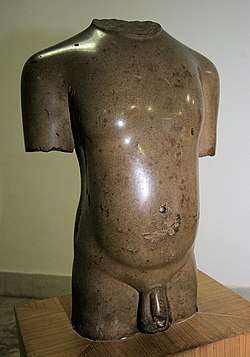Lohanipur torso
| Lohanipur torso | |
|---|---|
 Lohanipur torso, Patna Museum. | |
| Material | Polished sandstone |
| Period/culture | 3rd century BCE ~ 2nd century CE |
| Discovered | 25°36′23″N 85°09′16″E / 25.606366°N 85.154401°ECoordinates: 25°36′23″N 85°09′16″E / 25.606366°N 85.154401°E |
| Place | Lohanipur, Patna, Bihar, India. |
| Present location | Patna Museum, India |
 Lohanipur | |
The Lohanipur torso is a statue of polished sandstone, dated to the 3rd century BCE ~ 2nd century CE, found in Lohanipur, a central Division of Patna, ancient Pataliputra, Bihar, India.[1] There are some claims however for a later date (after the 1st century CE), as well as of Graeco-Roman influence in the sculpting.[2]
The Lohanipur torso is thought to represent the bust of a Jaina Tirthankara.[3][4]
The statue is an outstanding example of Mauryan polish, an advanced polishing technique essentially characteristic of the Mauryan Empire, which almost fell out of use after that period, although, if it is of a later date, it might suggest that polishing techniques survived the Mauryan era.[5]

The Lohanipur torso from various angles.
References
- ↑ Olivelle, Patrick (2006). Between the Empires: Society in India 300 BCE to 400 CE. Oxford University Press. p. 399. ISBN 9780199775071.
- ↑ Pereira, Jose (2001). Monolithic Jinas. Motilal Banarsidass Publ. p. 11. ISBN 9788120823976.
- ↑ Shah, Umakant Premanand (1995). Studies in Jaina Art and Iconography and Allied Subjects in Honour of Dr. U.P. Shah. Abhinav Publications. p. 15. ISBN 9788170173168.
- ↑ Patna Museum notice
- ↑ Pereira, Jose (2001). Monolithic Jinas. Motilal Banarsidass Publ. p. 10. ISBN 9788120823976.
This article is issued from
Wikipedia.
The text is licensed under Creative Commons - Attribution - Sharealike.
Additional terms may apply for the media files.